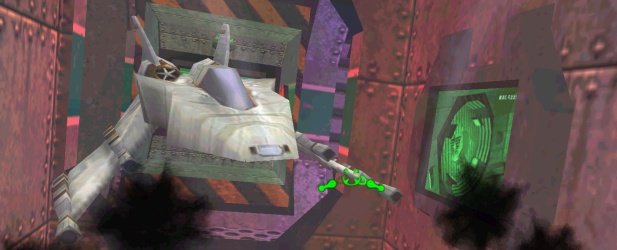
The 'feeding on excrement' and 'laying eggs on rotten flesh' part of being a fly has never really appealed, but I'd be lying if I said I hadn't occasionally watched a Musca Domestica alight on a ceiling or dodge a rolled-up magazine, and thought “Blimey. Imagine being able to aviate like that.”
Having just played through the still-special Descent 3, I'm more convinced than ever that our compound-eyed companions are having a whale of a time. In this 1999 sci-fi flight curio not only can you move forwards, backwards and sideways at the touch of a key, you can also rise, sink, tilt, rotate, and hover. Combine these abilities with gravity-less maps crammed with aggressive aerobots and you have the recipe for one of the most liberating and disorientating combat games ever made.
People will tell you that the first two Descents are superior to the third, and those people are not idiots. I've chosen to return to the fray via the last game purely because it offered the smartest foes and the prettiest venues (I'm shallow like that). When development started in 1996, the 3D card revolution was just kicking off. Outrage wisely chose to ditch their faithful software renderer. The result was a game that outhandsomed almost everything on the market. Even today, the way the glowing sputum of battle illuminates walls and bulkheads is very pleasant on the eye.

So too are many of the elaborately wrought interiors. Though one of D3's proudest boasts was its introduction of topside environments (plains, hills, valleys and streets) it's the subterranean spaces that steal the show. The vast reactor halls, cathedral-like hanger systems, and cramped mazes of ducts and corridors, where you'll spend most of your time, are amazingly varied and mind-bendingly omni-directional. With lurking enemies, floating power-ups, and shot-activated hatches appearing just as frequently above or below your craft as in front or to the side, you rapidly learn to let go of useless notions such as 'floor', 'ceiling' and 'wall'.
Not being rebuked by gravity every few seconds, or constantly reminded through architectural or HUD cues, which way is up, encourages a gloriously playful aerobaticism. Before long you're flitting about like a juvenile swallow on the first day of swallow-school summer hols. Curving corridor? Think I'll take that with afterburner on and at a 40 degree bank angle because it will look way cooler that way. Pipe running down the centre of this chamber? Reckon I'll corkscrew round it while plasma-bolting those turrets over there. This insane freedom is half the appeal of D3.
The other half is trashing the 24 different kinds of death automata Outrage have thoughtfully provided. Behaviour circuits scrambled by a dastardly virus, many of these devices once served as industrial drones. Now they use their rivet guns, welding lances, and salvage claws for darker purposes, ie, tearing you a new one.
Anyone perfectly happy with their old one (93% of gamers – Gastroenterology Ed) will need to be quick-fingered and super-spatially aware to survive. They'll also want to get to know their enemies' species-specific quirks.
Keep up to date with the most important stories and the best deals, as picked by the PC Gamer team.
Assault on a miner
Bots such as gangly mining droid Old Scratch rely wholly on melee, and will close rapidly when alerted. Others like the lumbering Thresher are content to sit back and pound you with missiles or energy gobbets. One of the most troublesome targets is the Thief, a diminutive ex-quarry droid that likes to ram, jolting loose precious weapons.
Slowly you learn which of the 25 weapon types to use in what circumstances. Strongarmed Tubbs can be kept at bay with blasts from the Vaus cannon. Small Sharcs can be lit-up with the flamer, then pummelled to death with a few pink fusion spheres. Gunboy turrets and prox mines deal with pursuing Hunters. Every munition has a mission in D3.
And talking of missions, most of the 17 stand up pretty well a decade on. Apart from the odd ill-judged boss fight and thorny puzzle, and a train-dodging section in Mission 4 that illustrates perfectly why the First-Person Frogger sub-genre never took off.
You play Material Defender, a shaft-explorer shafted by his employers, mining conglomerate PTMC. If Dravis, the sinister boss of PTMC, is to be brought to justice and his devastating robo-virus eliminated, you and your little ship are going to have to singlehandedly pull off a string of hair-raising heists, prison breaks, sabotage and defence missions.

You're not totally alone. D3's Companion Cube is a hovering hunk of helpfulness called Guide Bot. As its name suggests, the primary purpose of this attentive attendant is to guide you through the labyrinthine bowels of the various complexes. One click releases him from the protective cocoon of the ship, another sends him scurrying him off to a location of your choice, be it a mission objective, or a manually dropped marker beacon. If you fall behind, he'll double-back and urge you on with a cute R2-D2 chirrup. If you lose sight of him, he'll fire a bright flare to catch your eye.
Guide Bot will also help you locate power-ups, energy, and targets, and – assuming you've got the appropriate upgrade – provide limited fire support. Perhaps his most endearing role, though, is as emergency firefighter. Should you get bushwhacked by a napalm-spewing Gyro he'll dart over and get busy with his extinguisher. Sod all that Last Rolo nonsense, a willingness to quench flames – that's the sign of a true friend.
Whether you return for the companionship or the stirring six-degrees-of-freedom skirmishes, Descent 3 shouldn't disappoint.

